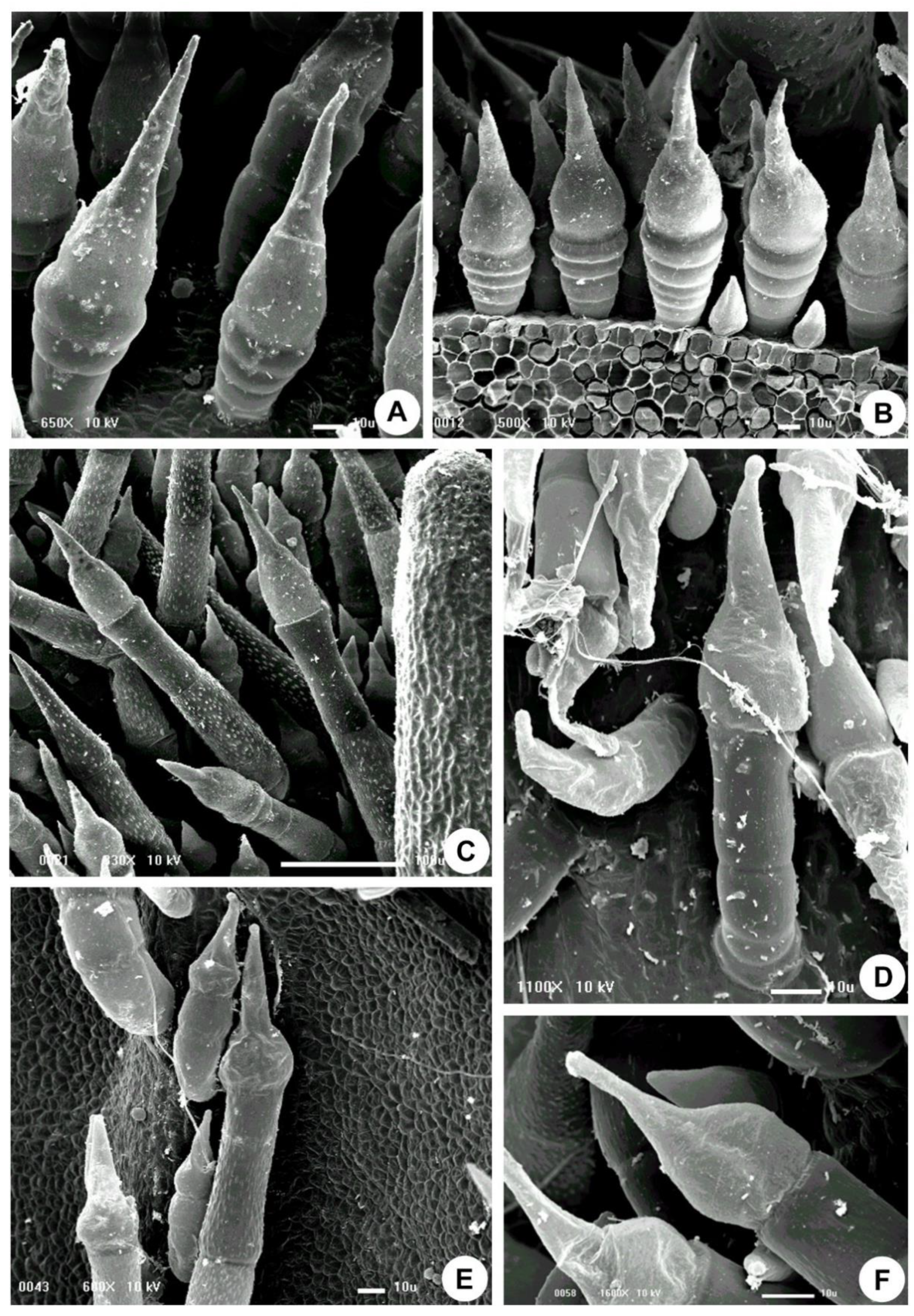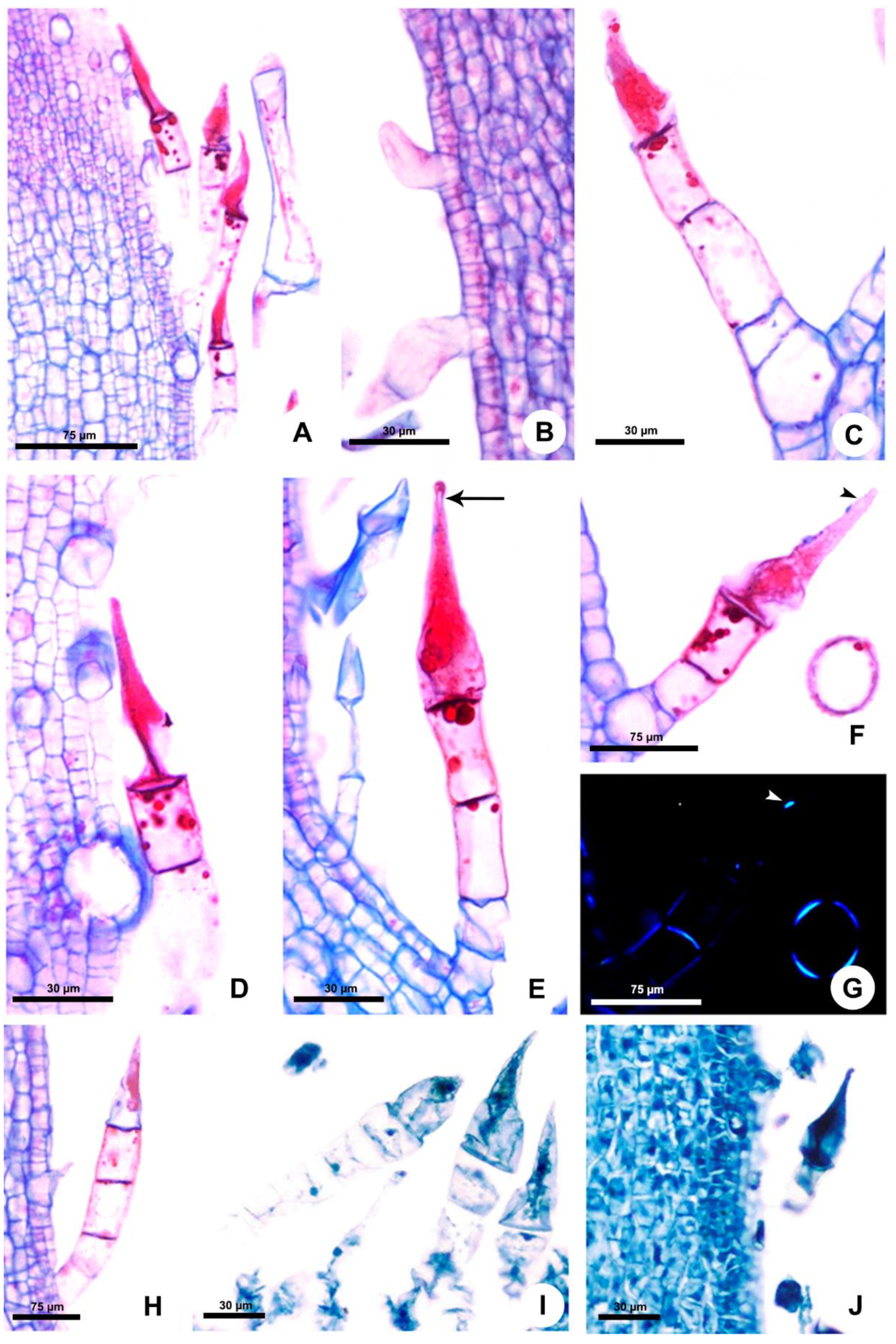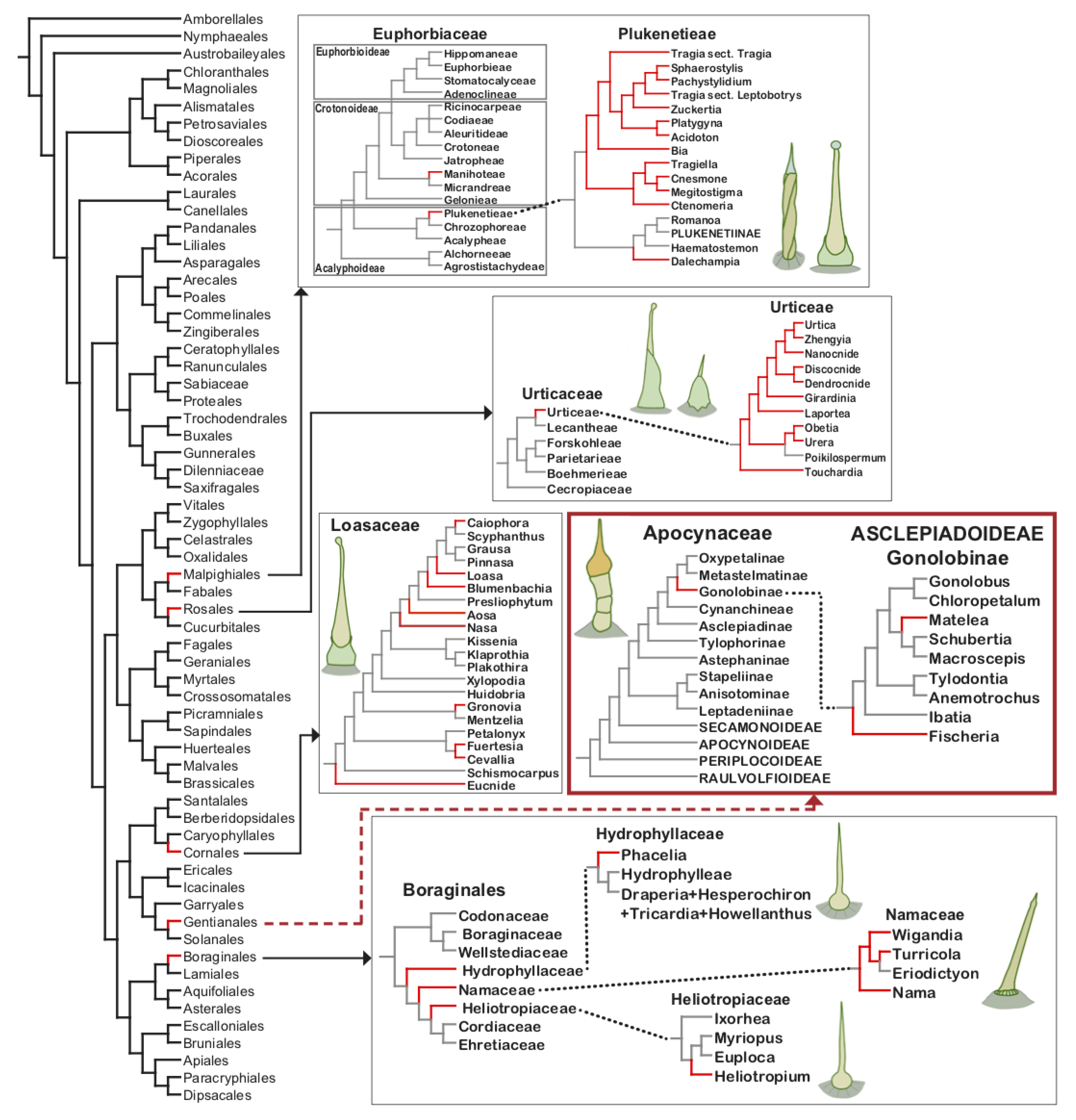Stinging Trichomes in Apocynaceae and Their Evolution in Angiosperms
Abstract
:1. Introduction
2. Results
Stinging Trichomes
3. Discussion
3.1. Structure
3.2. Function
3.3. Occurrence and Evolution of Stinging Trichomes
3.3.1. Rosales
3.3.2. Malpighiales
3.3.3. Boraginales
| Family | Subfamily | Tribe | Genus | References |
|---|---|---|---|---|
| Apocynaceae | Asclepiadoideae | Asclepiadeae | Fischeria | this study |
| Matelea | ||||
| Namaceae | - | - | Nama | [54,55] |
| Turriculia | [35,36] | |||
| Wigandia | [5,28,54,56] | |||
| Hydrophyllaceae | - | - | Phacelia | [22,35,54,57] |
| Heliotropiacae | - | - | Heliotropium | [58] |
| Euphorbiaceae | Acalyphoideae | Plukenetieae | Acidoton | [6,42] |
| Bia | [42] | |||
| Cnesmone | [5,6,33] | |||
| Ctenomeria | [42] | |||
| Dalechampia | [5,6,59] | |||
| Megistostigma | [42] | |||
| Pachystylidium | [5,31] | |||
| Platygyna | [5,42] | |||
| Sphaerostylis | [5,31,60] | |||
| Tragia | [5,19,31,32,59,61] | |||
| Tragiella | [5] | |||
| Zuckertia | [42] | |||
| Crotonoideae | Manihoteae | Cnidoscolus | [5,62,63,64,65] | |
| Loasaceae | Gronovioideae | - | Cevallia | [66] |
| Fuertesia | [67] | |||
| Gronovia | [66] | |||
| Mentzelioideae | - | Eucnide | [68] | |
| Loasoideae | Loaseae | Aosa | [21,23] | |
| Blumenbachia | [5,21,69] | |||
| Caiophora | [21,22,69,70] | |||
| Loasa | [21,22,69] | |||
| Nasa | [21,23] | |||
| Urticaceae | - | Urticeae | Dendrocnide | [38,50] |
| Discocnide | [50] | |||
| Girardinia | [5,50] | |||
| Gyrotaenia | [5] | |||
| Hesperocnide | [5,50] | |||
| Laportea | [5,50] | |||
| Nanocnide | [5,50] | |||
| Obetia | [5,50] | |||
| Urera | [5,50] | |||
| Urtica | [5,22,71] | |||
| Zhengyia | [50] |
3.3.4. Cornales
3.3.5. Gentianales
4. Materials and Methods
5. Conclusions
Author Contributions
Funding
Acknowledgments
Conflicts of Interest
References
- Fahn, A. Secretory Tissues in Plants; Academic Press: London, UK, 1979. [Google Scholar]
- Fahn, A. Secretory tissues and factors influencing their development. Phyton 1988, 28, 13–26. [Google Scholar]
- Levin, D.A. The role of trichomes in plant defense. Q. Rev. Biol. 1973, 48, 3–15. [Google Scholar] [CrossRef]
- Macfarlane, W.V. The stinging properties of Laportea. Econ. Bot. 1963, 17, 303–311. [Google Scholar] [CrossRef]
- Thurston, E.L.; Lersten, N. The morphology and toxicology of plant stinging hairs. Bot. Rev. 1969, 35, 393–412. [Google Scholar] [CrossRef]
- Thurston, E.L. An anatomical and Fine Structure Study of Stinging Hairs in Some Members of the Urticaceae, Euphorbiaceae and Loasaceae. Ph.D. Thesis, Iowa State University, Ames, IA, USA, 1969. [Google Scholar]
- APG. An update of the Angiosperm Phylogeny Group classification for the orders and families of flowering plants: APG IV. Bot. J. Linn. Soc. 2016, 181, 1–20. [Google Scholar] [CrossRef] [Green Version]
- Solereder, H. Systematic Anatomy of the Dicotyledons, 2nd ed.; Clarendon Press: Oxford, UK, 1908. [Google Scholar]
- Woodson, R.E. The North American Asclepiadaceae. I. Perspective of the genera. Ann. Mo. Bot. Gard. 1941, 28, 193–244. [Google Scholar] [CrossRef]
- Metcalfe, C.R.; Chalk, L. Anatomy of Dicotyledons; Clarendon Press: Oxford, UK, 1950. [Google Scholar]
- Stevens, W.D. Notes on the genera Matelea (Apocynaceae s.l.). Phytologia 1975, 32, 387–406. [Google Scholar]
- Murphy, H. A revision of the genus Fischeria (Asclepiadaceae). Syst. Bot. 1986, 11, 229–241. [Google Scholar] [CrossRef]
- Morillo, G. Matelea gracieae Morillo, a new species from French Guiana, and Cynanchum gortsianum Morillo, a new record for Suriname. Brittonia 1998, 50, 296–300. [Google Scholar] [CrossRef]
- Stevens, W.D. A synopsis of Matelea sub. Dictyanthus (Apocynaceae: Asclepiadoideae). Ann. Mo. Bot. Gard. 1988, 75, 1533–1564. [Google Scholar] [CrossRef]
- Morillo, G. Aportes al conocimiento de las Gonolobinae (Apocynaceae-Asclepiadoideae). Pittieria 2012, 36, 13–57. [Google Scholar]
- Morillo, G. Aportes al conocimiento de las Gonolobinae II (Apocynaceae, Asclepiadoideae). Pittieria 2013, 37, 115–154. [Google Scholar]
- Morillo, G.; Keller, H.A. Un nuevo género y dos nuevas combinaciones en las Gonolobinae (Apocynaceae: Asclepiadoideae). Bonplandia 2016, 25, 129–143. [Google Scholar] [CrossRef]
- Thurston, E.L. Morphology, fine structure and ontogeny of the stinging emergence of Urtica dioica. Am. J. Bot. 1974, 61, 809–817. [Google Scholar] [CrossRef]
- Thurston, E.L. Morphology, fine structure and ontogeny of the stinging emergence of Tragia ramosa and T. saxicola (Euphorbiaceae). Am. J. Bot. 1976, 63, 710–718. [Google Scholar] [CrossRef]
- Barber, D.A.; Shone, M.G.T. The absorption of silica from aqueous solutions by plants. J. Exp. Bot. 1966, 17, 569–578. [Google Scholar] [CrossRef]
- Ensikat, H.J.; Mustafa, A.; Weigend, M. Complex patterns of multiple biomineralization in single-celled plant trichomes of the Loasaceae. Am. J. Bot. 2017, 104, 195–206. [Google Scholar] [CrossRef] [Green Version]
- Weigend, M.; Mustafa, A.; Ensikat, H.J. Calcium phosphate in plant trichomes: The overlooked biomineral. Planta 2018, 247, 277–285. [Google Scholar] [CrossRef]
- Mustafa, A.; Ensikat, H.J.; Weigend, M. Ontogeny and the process of biomineralization in the trichomes of Loasaceae. Am. J. Bot. 2017, 104, 367–378. [Google Scholar] [CrossRef] [Green Version]
- Mustafa, A.; Ensikat, H.J.; Weigend, M. Mineralized trichomes in Boraginales: Complex microscale heterogeneity and simple phylogenetic patterns. Ann. Bot. 2018, 121, 741–751. [Google Scholar] [CrossRef]
- Corsi, G. Urtica membranacea pearl glands. II-Some aspects of nuclear metabolism. Phyton 1994, 34, 95–102. [Google Scholar]
- Thurston, R.; Smith, W.T.; Cooper, B.P. Alkaloid secretion by trichomes of Nicotiana species and resistance to aphids. Entomol. Exp. Appl. 1966, 9, 428–432. [Google Scholar] [CrossRef]
- Thurston, R. Toxicity of trichome exudates of Nicotiana and Petunia species to tobacco hornworm larvae. J. Econ. Entomol. 1970, 63, 272–274. [Google Scholar] [CrossRef]
- Pérez-Estrada, L.B.; Cano-Santana, Z.; Oyama, K. Variation in leaf trichomes of Wigandia urens: Environmental factors and physiological consequences. Tree Physiol. 2000, 20, 629–632. [Google Scholar] [CrossRef] [PubMed] [Green Version]
- Oliveira, D.M.; Pimentel, L.A.; Araújo, J.A.S.; Rosane, M.T.; Dantas, A.F.M.; Riet-Correa, F. Intoxicação por Cnidoscolus phyllacanthus (Euphorbiaceae) em caprinos. Pesquisa Veterinaria Brasileira 2008, 28, 36–42. [Google Scholar] [CrossRef] [Green Version]
- Noguera-Savelli, E.; Jáuregui, D.; Ruiz-Zapata, T. Caracterización del indumento de nueve especies de Loasaceae de Venezuela. Rev. Mex. Biodivers. 2009, 80, 751–762. [Google Scholar] [CrossRef]
- Fu, H.Y.; Chen, S.J.; Chen, R.F.; Kuo-Huang, L.L.; Huang, R.N. Why do nettles sting? About stinging hairs looking simple but acting complex. Funct. Plant Sci. Biotecnol. 2007, 1, 46–55. [Google Scholar]
- Forster, P.I. A taxonomic revision of Tragia (Euphorbiaceae) in Australia. Aust. Syst. Bot. 1994, 7, 377–383. [Google Scholar] [CrossRef]
- Collier, H.O.; Chesher, G.B. Identification of 5-hydroxytryptamine in the sting of the nettle (Urtica dioica). Br. J. Pharmacol. Chemother. 1956, 11, 186–189. [Google Scholar] [CrossRef] [Green Version]
- Lookadoo, S.E.; Pollard, A.J. Chemical contents of stinging trichomes of Cnidoscolus texanus. J. Chem. Ecol. 1991, 17, 1909–1916. [Google Scholar] [CrossRef]
- Reynolds, G.W.; Proksch, P.; Rodriguez, E. Prenylated phenolics that cause contact dermatitis from glandular trichomes of Turricula parryi. Planta Med. 1985, 51, 494–498. [Google Scholar] [CrossRef]
- Reynolds, G.W.; Epstein, W.L.; Rodriguez, E. Unusual contact allergens from plants in the family Hydrophyllaceae. Contact Dermat. 1986, 14, 39–44. [Google Scholar] [CrossRef] [PubMed]
- Reynolds, G.W.; Rodriguez, E. Prenylated hydroquinones: Contact allergens from trichomes of Phacelia minor and P. parryi. Phytochemistry 1981, 20, 1365–1366. [Google Scholar] [CrossRef]
- Gilding, E.K.; Jami, S.; Deuis, J.R.; Israel, M.R.; Harvey, P.J.; Poth, A.G.; Rehm, F.B.H.; Stow, J.L.; Robinson, S.D.; Yap, K.; et al. Neurotoxic peptides from the venom of the giant Australian stinging tree. Sci. Adv. 2020, 6, eabb8828. [Google Scholar] [CrossRef]
- Huang, X.; Deng, T.; Moore, M.J.; Wang, H.; Li, Z.; Lin, N.; Yusupov, Z.; Tojibaev, K.S.; Wang, Y.; Sun, H. Tropical Asian origin, boreotropical migration and long-distance dispersal in nettles (Urticeae, Urticaceae). Mol. Phylogenet. Evol. 2019, 137, 190–199. [Google Scholar] [CrossRef] [PubMed]
- Wu, Z.Y.; Monro, A.K.; Milne, R.I.; Wang, H.; Yi, T.S.; Liu, J.; Li, D.Z. Molecular phylogeny of the nettle family (Urticaceae) inferred from multiple loci of three genomes and extensive generic sampling. Mol. Phylogenet. Evol. 2013, 69, 814–827. [Google Scholar] [CrossRef]
- Wurdack, K.J.; Hoffmann, P. Molecular phylogenetic analysis of uniovulate Euphorbiaceae (Euphorbiaceae sensu stricto) using plastid rbcL and trnL-F DNA sequences. Am. J. Bot. 2005, 92, 1397–1420. [Google Scholar] [CrossRef]
- Cardinal-McTeague, W.M.; Gillespie, L.J. Molecular phylogeny and pollen evolution of Euphorbiaceae tribe Plukenetieae. Syst. Bot. 2016, 41, 329–347. [Google Scholar] [CrossRef] [Green Version]
- Castillo, R.A.; Luebert, F.; Henning, T.; Weigend, M. Major lineages of Loasaceae subfam. Loasoideae diversified during the Andean uplift. Mol. Phylogenet. Evol. 2019, 141, 106616. [Google Scholar] [CrossRef]
- Hufford, L.; McMahon, M.M.; O’Quinn, R.; Poston, M.E. A Phylogenetic analysis of Loasaceae subfamily Loasoideae based on plastid DNA sequences. Int. J. Plant Sci. 2005, 166, 289–300. [Google Scholar] [CrossRef] [Green Version]
- Mangelsdorff, R.D.; Meve, U.; Liede-Schumann, S. Phylogeny and circumscription of Antillean Anemotrochus, gen. nov., and Tylodontia (Apocynaceae: Asclepiadoideae: Gonolobinae). Willdenowia 2016, 46, 443–474. [Google Scholar] [CrossRef] [Green Version]
- Nazar, N.; Clarkson, J.J.; Goyder, D.; Kaky, E.; Mahmood, T.; Chase, M.W. Phylogenetic relationships in Apocynaceae based on nuclear PHYA and plastid trnL-F sequences, with a focus on tribal relationships. Caryologia 2019, 72, 55–81. [Google Scholar]
- Hasenstab-Lehman, K.E. Phylogenetics of the Borage family: Delimiting Boraginales and assessing closest relatives. Aliso 2017, 35, 41–49. [Google Scholar] [CrossRef]
- Vasile, M.-A.; Jeiter, J.; Weigend, M.; Luebert, F. Phylogeny and historical biogeography of Hydrophyllaceae and Namaceae, with a special reference to Phacelia and Wigandia. Syst. Biodivers. 2020, 18, 757–770. [Google Scholar] [CrossRef]
- Hilger, H.H.; Diane, N. A systematic analysis of Heliotropiaceae (Boraginales) based on trnL and ITS1 sequence data. Botanische Jahrbücher fur Systematik 2003, 125, 19–52. [Google Scholar] [CrossRef]
- Kim, C.; Deng, T.; Chase, M.; Zhang, D.G.D.; Nie, Z.L.Z.; Sun, H. Generic phylogeny and character evolution in Urticeae (Urticaceae) inferred from nuclear and plastid DNA regions. Taxon 2015, 64, 65–78. [Google Scholar] [CrossRef]
- Jiarui, C.; Qi, L.; Friis, I.; Wilmot-Dear, C.M.; Monro, A.K. Urticaceae. In Flora of China; Wu, Z., Raven, P.H., Eds.; Science Press: Beijing, China, 2003; Volume 5, pp. 76–189. [Google Scholar]
- Radcliffe-Smith, A. Genera Euphorbiacearum; Royal Botanic Gardens, Kew: London, UK, 2001. [Google Scholar]
- Luebert, F.; Cecchi, L.; Frohlich, M.W.; Gottschling, M.; Guilliams, C.M.; Hasenstab-Lehman, K.E.; Hilger, H.H.; Miller, J.S.; Mittelbach, M.; Nazaire, M.; et al. Familial classification of the Boraginales. Taxon 2016, 65, 502–522. [Google Scholar] [CrossRef] [Green Version]
- Aregullin, M.; Rodriguez, E. Hydrophyllaceae. In Dermatologic Botany; Avalos, J., Maibach, H.I., Eds.; CRC Press: New York, NY, USA, 1999. [Google Scholar]
- Binder, B.F. Trichomes of Nama (Hydrophyllaceae) that produce insect-active compounds. Aliso 1995, 14, 35–39. [Google Scholar] [CrossRef] [Green Version]
- Constance, L. Chromosome number and classification in Hydrophyllaceae. Brittonia 1963, 15, 273–285. [Google Scholar] [CrossRef]
- Walden, G.K.; Patterson, R. Nomenclatural kankedorts in Phacelia (Boraginaceae: Hydrophylloideae). Madroño 2011, 58, 267–272. [Google Scholar] [CrossRef]
- Alwahibi, M.; Bukhary, N. Anatomical study of four species of Heliotropium L. (Boraginaceae) from Saudi Arabia. Afr. J. Plant Sci. 2013, 7, 35–42. [Google Scholar] [CrossRef] [Green Version]
- Inamdar, J.A.; Gangadhara, M. Studies on the trichomes of some Euphorbiaceae. Feddes Repertorium 1977, 88, 103–111. [Google Scholar] [CrossRef]
- Webster, G.L. Irritant plants in the spurge family (Euphorbiaceae). Clin. Dermatol. 1986, 4, 36–45. [Google Scholar] [CrossRef]
- Radcliffe-Smith, A. Notes on African Euphorbiaceae: XIII. Tragia, Tragiella &c. Kew Bull. 1983, 37, 683–691. [Google Scholar]
- McVaugh, R. The genus Cnidoscolus: Generic limits and intrageneric groups. Bull. Torrey Bot. Club 1944, 71, 457–474. [Google Scholar] [CrossRef]
- Pollard, A.J. Variation in Cnidoscolus texanus in relation to herbivory. Oecologia 1986, 70, 411–413. [Google Scholar] [CrossRef]
- Melo, A.L.; Sales, M.F. O gênero Cnidoscolus Pohl (Crotonoideae-Euphorbiaceae) no Estado de Pernambuco, Brasil. Acta Bot. Bras. 2008, 22, 806–827. [Google Scholar] [CrossRef] [Green Version]
- Maya-Lastra, C.A.; Steinmann, V.W. Evolution of the untouchables: Phylogenetics and classification of Cnidoscolus (Euphorbiaceae). Taxon 2019, 68, 692–713. [Google Scholar] [CrossRef]
- Kubitzki, K. Families and Genera of Vascular Plants. Flowering Plants. Dicotyledons: Celastrales, Oxalidales, Rosales, Cornales, Ericales, 6th ed.; Springer: Heidelberg, Germany, 2004. [Google Scholar]
- Evans, F.J.; Schmidt, R.J. Plants and plant products that induce contact dermatitis. J. Med. Plants Res. 1980, 38, 289–316. [Google Scholar] [CrossRef] [Green Version]
- Waterfall, U.T. A revision of Eucnide. Rhodora 1959, 61, 231–243. [Google Scholar]
- Ensikat, H.J.; Geisler, T.; Weigend, M. A first report of hydroxylated apatite as structural biomineral in Loasaceae-plants’ teeth against herbivores. Sci. Rep. 2016, 6, 26073. [Google Scholar] [CrossRef] [Green Version]
- Ackermann, M.; Weigend, M. Notes on the genus Caiophora (Loasoideae, Loasaceae) in Chile and neighbouring countries. Darwiniana 2007, 45, 45–67. [Google Scholar]
- Gangadhara, M.; Inamdar, J.A. Trichomes and stomata, and their taxonomic significance in the Urticales. Plant Syst. Evol. 1977, 127, 121–137. [Google Scholar] [CrossRef]
- Walden, G.K.; Garrison, L.M.; Spicer, G.S.; Cipriano, F.W.; Patterson, R. Phylogenies and chromosome evolution of Phacelia (Boraginaceae: Hydrophylloideae) inferred from nuclear ribosomal and chloroplast sequence data. Madroño 2014, 61, 16–47. [Google Scholar] [CrossRef]
- Hofmann, M.; Walden, G.K.; Hilger, H.H.; Weigend, M. Hydrophyllaceae. In Flowering Plants. Eudicots; Kadereit, J.W., Bittrich, V., Eds.; Springer: Cham, Switzerland, 2016; Volume 14, pp. 221–238. [Google Scholar]
- Tölke, E.; Carmello-Gerreiro, S.M.; Miranda de Melo, J.I. Leaf anatomy of six species of Heliotropiaceae Schrad. from the Brazilian semi-arid region. Biotemas 2015, 28, 1–13. [Google Scholar] [CrossRef]
- Hufford, L.; McMahon, M.M.; Sherwood, A.M.; Reeves, G.; Chase, M.W. The major clades of Loasaceae: Phylogenetic analysis using the plastid matK and trnL-trnF regions. Am. J. Bot. 2003, 90, 1215–1228. [Google Scholar] [CrossRef] [PubMed]
- Moddy, M.L.; Hufford, L.; Soltis, D.E.; Soltis, P.S. Phylogenetic relationships of Loasaceae subfamily Gronovioideae inferred from matK and ITS sequence data. Am. J. Bot. 2001, 88, 326–336. [Google Scholar] [CrossRef]
- Endress, M.E.; Liede-Schumann, S.; Meve, U. An updated classification for Apocynaceae. Phytotaxa 2014, 159, 175–194. [Google Scholar] [CrossRef]
- Liede, S. Subtribes and genera of the tribe Asclepiadeae (Apocynaceae, Asclepiadoideae). A synopsis. Taxon 1999, 46, 233–247. [Google Scholar] [CrossRef]
- Liede, S.; Kunze, H. A descriptive system for corona analysis in Asclepiadaceae and Periplocaceae. Plant Syst. Evol. 1993, 185, 275–284. [Google Scholar] [CrossRef]
- Johansen, D.A. Plant Microtechnique; McGraw-Hill: New York, NY, USA, 1940. [Google Scholar]
- Lillie, R.D. Histopathologic Technic and Practical Histochemistry, 3rd ed.; McGraw-Hill: New York, NY, USA, 1965. [Google Scholar]
- Gerlach, D. Botanische Mikrotechnik: Eine Einführung, 3rd ed.; Georg Thieme: Stuttgart, Germany, 1984. [Google Scholar]
- Gregory, M.; Baas, P. A survey of mucilage cells in vegetative organs of the dicotyledons. Isr. J. Bot. 1989, 38, 125–174. [Google Scholar]
- Pizzolato, T.D. Staining of Tilia mucilages with Mayer’s tannic acid-ferric chloride. Bull. Torrey Bot. Club 1977, 104, 277–279. [Google Scholar] [CrossRef]
- McManus, J.F.A. Histological and histochemical uses of periodic acid. Stain. Technol. 1948, 23, 99–108. [Google Scholar] [CrossRef]
- Fisher, D.B. Protein staining of ribboned epon sections for light microscopy. Histochemie 1968, 16, 92–96. [Google Scholar] [CrossRef] [PubMed]
- Pearse, A.G.E. Histochemistry: Theoretical and Applied, 4th ed.; Churchill Livingstone: Edinburgh, UK, 1985. [Google Scholar]
- Cain, A.J. The use of Nile Blue in the examination of lipoids. J. Cell Sci. 1947, 88, 383–392. [Google Scholar]
- Ganter, P.; Jollés, G. Histochimie Normale et Pathologique; Gauthier-Villars: Paris, France, 1969; Volume 1. [Google Scholar]
- Ganter, P.; Jollés, G. Histochimie Normale et Pathologique; Gauthier-Villars: Paris, France, 1970; Volume 2. [Google Scholar]
- Demarco, D. Histochemical analysis of plant secretory structures. In Histochemistry of Single Molecules. Methods in Molecular Biology; Pellicciari, C., Biggiogera, M., Eds.; Humana Press: New York, NY, USA, 2017; Volume 1560, pp. 313–330. [Google Scholar]




| Histochemical Treatment | Detected Substance | Secretion | |
|---|---|---|---|
| Fs | Md | ||
| Ruthenium red | acidic mucilage | − | − |
| Tannic acid and ferric chloride | mucilage | − | − |
| PAS reaction | carbohydrates | − | − |
| Ferric chloride | phenolic compounds | − | − |
| Formalin-ferrous sulphate | phenolic compounds | − | − |
| Aniline blue black | proteins | + (Figure 3I) | + (Figure 3J) |
| Sudan black B | lipids | − | − |
| Sudan IV | lipids | − | − |
| Nile blue | neutral and acidic lipids | − | − |
| Copper acetate and rubeanic acid | fatty acids | − | − |
Publisher’s Note: MDPI stays neutral with regard to jurisdictional claims in published maps and institutional affiliations. |
© 2021 by the authors. Licensee MDPI, Basel, Switzerland. This article is an open access article distributed under the terms and conditions of the Creative Commons Attribution (CC BY) license (https://creativecommons.org/licenses/by/4.0/).
Share and Cite
Medina, M.C.; Sousa-Baena, M.S.; Capelli, N.d.V.; Koch, R.; Demarco, D. Stinging Trichomes in Apocynaceae and Their Evolution in Angiosperms. Plants 2021, 10, 2324. https://doi.org/10.3390/plants10112324
Medina MC, Sousa-Baena MS, Capelli NdV, Koch R, Demarco D. Stinging Trichomes in Apocynaceae and Their Evolution in Angiosperms. Plants. 2021; 10(11):2324. https://doi.org/10.3390/plants10112324
Chicago/Turabian StyleMedina, Maria Camila, Mariane S. Sousa-Baena, Natalie do Valle Capelli, Raquel Koch, and Diego Demarco. 2021. "Stinging Trichomes in Apocynaceae and Their Evolution in Angiosperms" Plants 10, no. 11: 2324. https://doi.org/10.3390/plants10112324







